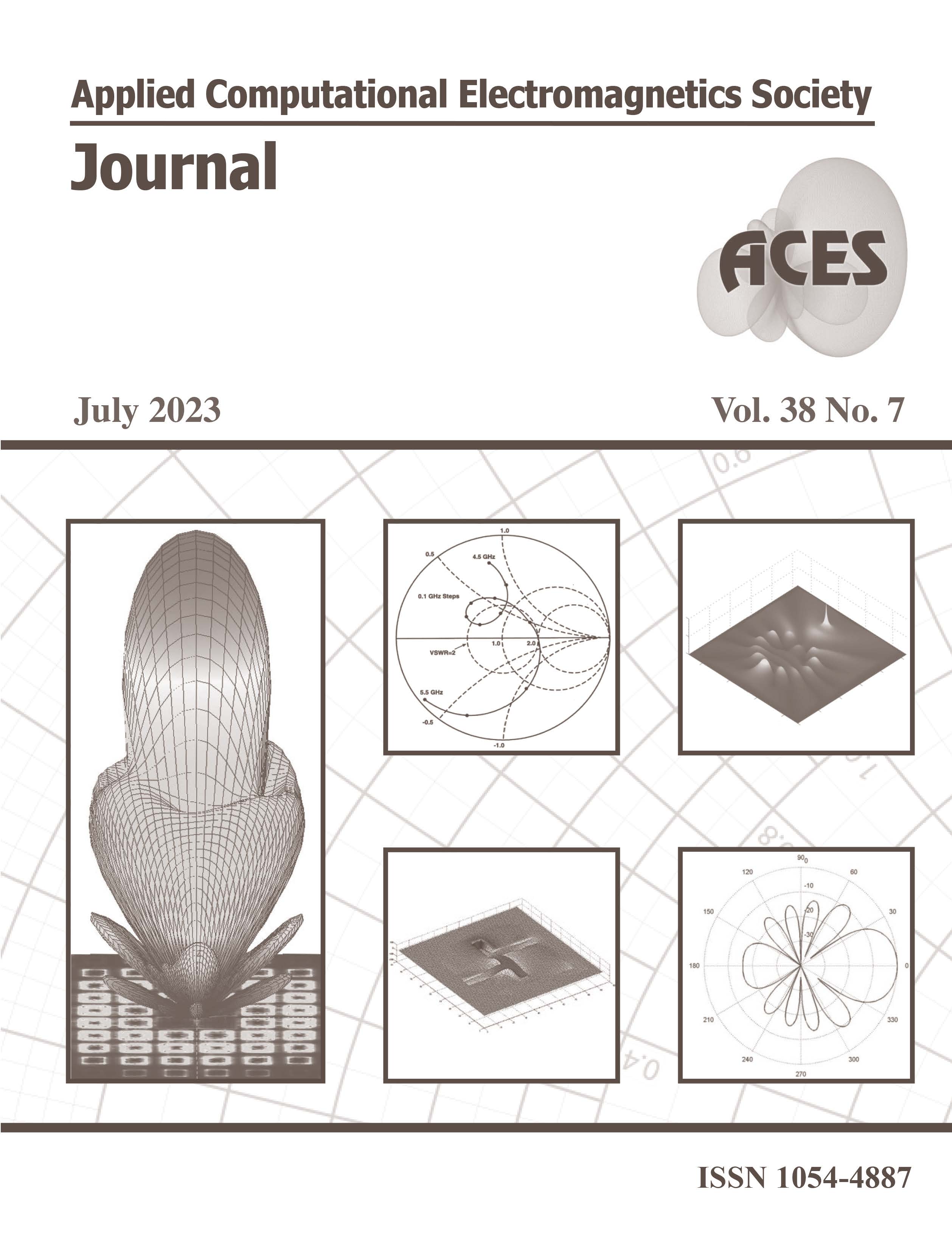Nanoarray of Vivaldi Rectenna for Infrared-energy Harvesting
DOI:
https://doi.org/10.13052/2023.ACES.J.380707Keywords:
Energy harvesting, infrared (IR) energy, MIM diode, rectenna, THz, Vivaldi antenna arrayAbstract
This article presents the design of an array of rectennas operating at 28.3 THz for infrared (IR) energy harvesting applications. The basic element of the array consists of a Vivaldi-dipole rectenna composed of two arms made with different conductors (gold and titanium). A metal-insulator-metal (MIM) tunnel diode is used to rectify the THz ac current. The proposed MIM diode consists of a very thin layer of Al2O3 sandwiched between the two metal electrodes. Arrays of two, three, and four rectennas are investigated. The improvement of the energy captured by coupling several elements in the same structure with a common gap is also investigated. This array architecture, without feeding network, may reduce the number of rectifying diodes and, therefore, decrease losses and increase the overall efficiency. Finally, it has been found that the four-elements rectenna array has a maximum electric field intensity of 62.4 × 104 V/m at 28.3 THz.
Downloads
References
X. W. Yao, D. B. Ma, and C. Han, “ECP: A probing-based error control strategy for THz-based nanonetworks with energy harvesting,” IEEE Access, vol. 7, pp. 25616-25626, 2019.
A. Takacs, H. Aubert, S. Fredon, L. Despoisse, and H. Blondeaux, “Microwave power harvesting for satellite health monitoring,” IEEE Trans. on Microwave Theory Tech, vol. 62, no. 4, pp. 1090-1098, April 2014.
F. Yildiz, “Potential ambient energy-harvesting sources and techniques,” J. Technol. Studies, vol. 35, no. 1, pp. 40-48, 2009.
W. T. Sethi, “Optical antennas for harvesting solar radiation energy,” Ph.D. Thesis, Rennes University, 2019.
R. Singh, G. F. Alapatt, and A. Lakhtakia, “Making solar cells a reality in every home: Opportunities and challenges for photovoltaic device design,” IEEE Journal of the Electron Devices Society, 2013.
A. Yahyaoui, A. Elsharabasy, J. Yousaf, K. Sedraoui, and H. Rmili, “MIIM-based optical log spiral rectenna for efficient IR energy harvesting,” Alexandria Engineering Journal, vol. 61, no. 11, pp. 8897-8909, 2022.
W. Amara, D. Oueslati, N. Eltresy, A. Alghamdi, K. Sedraoui, T. Aguili, H. Rmili, and R. Mittra, “Parametric study of modified dipole nano-antennas printed on thick substrates for infrared energy harvesting,” Int. J. Numer. Model., e2704. https://doi.org/10.1002/jnm.2704, 2019.
D. K. Kotter, W. D. Slafer, S. D. Novack, and P. Pinhero, “Solar antenna electromagnetic collectors,” ASME, Jacksonville, Florida, USA, 2008.
M. Gadalla, M.-R. Abdelrahman, and A. Shamim, “Design, optimization and fabrication of a 28.3 THz nano-rectenna for infrared detection and rectification,” Scientific Reports, 4:4270, DOI: 10.1038/srep04270, Mar. 2014.
W. Haboubi, H. Takhedmit, J.-D. L. S. Luk, S.-E. Adami, B. Allard, F. Costa, C. Vollaire, O. Picon, and L. Cirio, “An efficient dual-circularly polarized rectenna for RF energy harvesting in the 2.45 GHz ISM band. Progress in Electromagnetics Research, vol. 148, pp. 31-39, ff10.2528/ PIER14031103ff, 2014.
C. A. Reynaud, D. Duché, J.-J. Simon, E. Sanchez-Adaime, O. Margeat, J. Ackermann, V. Jangid, C. Lebouin, D. Brunel, F. Dumur, D. Gigmes, G. Berginc, C. A. Nijhuis, and L. Escoubas, “Rectifying antennas for energy harvesting from the micro-waves to visible light: A review,” Progress in Quantum Electronics, Elsevier, vol. 72, p. 100265, 2020.
O. P. Dimitriev, “Harvesting of the infrared energy: Direct collection, up-conversion, and storage,” Optoelectronics and Optoelectronic Devices, SPQEO, vol. 22, no. 4, pp. 457-469, 2019.
J. Shank, E. A. Kadlec, D. W. Peters, and P. S. Davids, “Infrared nanoantenna-coupled rectenna for energy harvesting,” IEEE Aerospace Conference, Big Sky, MT, USA, pp. 2-9, March 2019.
P. Biagioni, J. S. Huang, and B. Hecht, “Nano-antennas for visible and infrared radiation,” Rep. Prog. Phys., vol. 75, no. 024402, 2012.
C. De Angelis, A. Locatelli, D. Modotto, S. Boscolo, M. Midrio, F. Sacchetto, A. D. Capobianco, F. M. Pigozzo, and C. G. Someda, “Extending antenna theory to the optical domain,” 2009 European Microwave Conference (EuMC), 2009.
G. A. E. Vandenbosch, Plasmonics - Principles and Applications, intechOpen, 2012.
M. Mivelle, “Etude et developpement de nano-antennes brees pour la microscopie en champ proche optique et la nano-photonique,” Ph.D. Thesis, September-October 2009.
J. Paparone, “Contrôle de l’émission dans des nano-structures plasmoniques: Nanoantennesmultimères et plasmons long-range,” Optique/photonique, Ph.D. Thesis, Université Lyon 1 – Claude Bernard, 2016.
E. G. Arsoy, M. Inac, A. Shafique, M. Ozcan, and Y. Gurbuz, “The metal-insulator-metal diodes for infrared energy harvesting and detection appli-cations,” Proc. SPIE 9819, Infrared Technology and Applications XLII, May 20, 2016.
M. Aldrigo, D. Masotti, V. Rizzoli, and A. Costanzo, “Design rules for innovative nano-rectennas in the infrared region,” 2013 European Microwave Conference, Nuremberg, pp. 1-4, 2013.
A. Sabaawi, C. Tsimenidis, and B. Sharif, Rectenna Solar Cells. 10.1007/978-1-4614-3716-1_11, 2013.
A. M. A. Sabaawi, C. C. Tsimenidis, and B. S. Sharif, “Planar bowtie nanoarray for Thz energy detection,” IEEE Transactions on Terahertz Science and Technology, vol. 3, no. 5, pp. 1-8, 2013.
A. M. A. Sabaawi, C. Tsimenidis, and B. Sharif, “Bow-tie nano-array rectenna: Design and optimi-zation,” Antennas and Propagation (EUCAP), 2012 6th European Conference on IEEE, pp. 1975-1978, 2012.
CST Microwave Studio, ver. 2012, Computer Simulation Technology, Framingham, MA, 2012.
C. A. Balanis, Antenna Theory: Analysis and Design, 2005.
A. W. A. Sabaawi, C. C. Tsimenidis, and B. S. Sharif, “Infra-red nano-antennas for solar energy collection,” Loughborough Antennas and Propa-gation Conference (LAPC), pp. 1-4, 2011.




